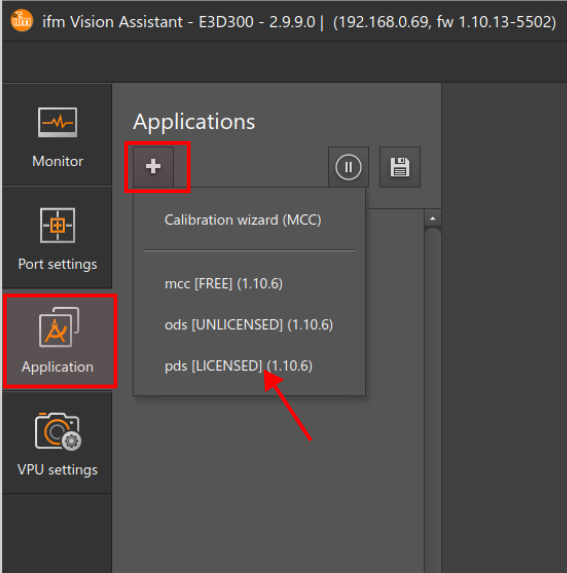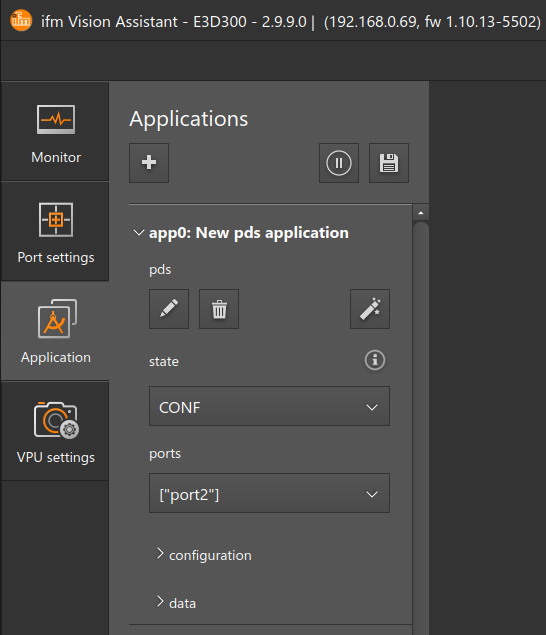Configuration
The PDS application is instantiated with a set of JSON parameters.
A minimal instantiation is as follows, where "app0" can be replaced by another app index if required:
{
"applications":{
"instances":{
"app0":{
"class": "pds"
}
}
}
}
This is equivalent to creating a PDS app in the Vision Assistant:


The app will be instantiated with all parameters set to their default values. The parameters can be further configured and are described below.
Note
When using multiple applications on a single device, keep in mind that the maximum number of simultaneous application instances is 20. The maximum number of application of each type that can be configured is:
1 ODS application
2 PDS applications
1 PLC application
8 MCC applications
8 SCC applications
Multiple applications using the same camera cannot be active at the same time. Switch all the applications to CONF except the one currently running.
General parameters
Property |
Type |
Description |
Default |
Minimum |
Maximum |
Enumeration |
|---|---|---|---|---|---|---|
|
string |
Application class |
N/A |
N/A |
N/A |
|
|
integer |
Version number for the parameters. |
0 |
0 |
N/A |
N/A |
|
integer |
Version number for algo-debug. |
N/A |
0 |
N/A |
N/A |
|
array |
PCIC outputs that are produced by the application |
N/A |
N/A |
N/A |
N/A |
|
integer |
PCIC output TCP/IP port of the application |
N/A |
N/A |
N/A |
N/A |
|
string |
User-defined application name |
N/A |
N/A |
N/A |
N/A |
|
array |
N/A |
[‘port2’] |
N/A |
N/A |
N/A |
|
string |
Application state |
CONF |
N/A |
N/A |
|
Note
When setting the application state to RUN, PDS data will be streamed at 10Hz by default.
The framerate can be changed at /applications/instances/appX/port/acquisition/framerate.
The RUN mode is available for all three commands, getPallet, getRack and volCheck.
Customization parameters at configuration/customization
These parameters are available at the configuration/customization path in the JSON configuration. These parameters allow users to quickly adapt the detection system to their environment with minimal input.
Recommended for:
Users who want to set up the system with minimal adjustments.
Situations where the detection environment is consistent, and default settings are sufficient.
Configuring high-level properties like pallet type, detection order, or defining the Volume of Interest (VOI).
Example:
For example, to detect a standard pallet in a warehouse when the approximate distance from the camera is known, you would just need to adjust the depthHint and select the appropriate palletIndex.
Parameters:
Property |
Type |
Description |
Default |
Minimum |
Maximum |
Enumeration |
|---|---|---|---|---|---|---|
|
string |
PDS command to be executed. When the execution has finished, this field will automatically switch back to nop (No Operation) |
nop |
N/A |
N/A |
|
|
Customization parameters for the |
|||||
|
Customization parameters for the |
|||||
|
Customization parameters for the |
Fine-tuning parameters at configuration/parameter
These parameters are available at the configuration/parameter path in the JSON configuration.
Important
The default parameters can detect most commonly used pallets/racks. However, if the pallet/rack is not detected with default set of parameters then please contact the ifm support team at support.efector.object-ident@ifm.com for tuning the parameters.
These parameters should be used when fine-tuning the detection algorithm for optimal performance in complex or variable environments.
Recommended usage:
Users who need to improve accuracy and speed in challenging detection scenarios.
Pallets of varying sizes or material.
Racks of non-standard sizes.
etc.
Example: For example, the user can adjust the bounding box dimensions with getPallet/x/orthoProjection/voi/xMax and xMin to focus the detection on specific areas and therefore increase the detection speed.
Parameters:
getPallet, getRack and volCheck can all be fine tuned in specific ways.
For more details on each of the parameters, refer to the respective documentation: getPallet parameters, getRack parameters and volCheck parameters.
Port parameters at configuration/port
These parameters are available at the configuration/port path in the JSON configuration.
These parameters mirror the port parameters available at the /ports/portX path in the JSON configuration.
They are used to configure acquisition settings and filtering for the port. Typically, these settings do not need to be updated, as the application provides reasonable defaults for most use cases.